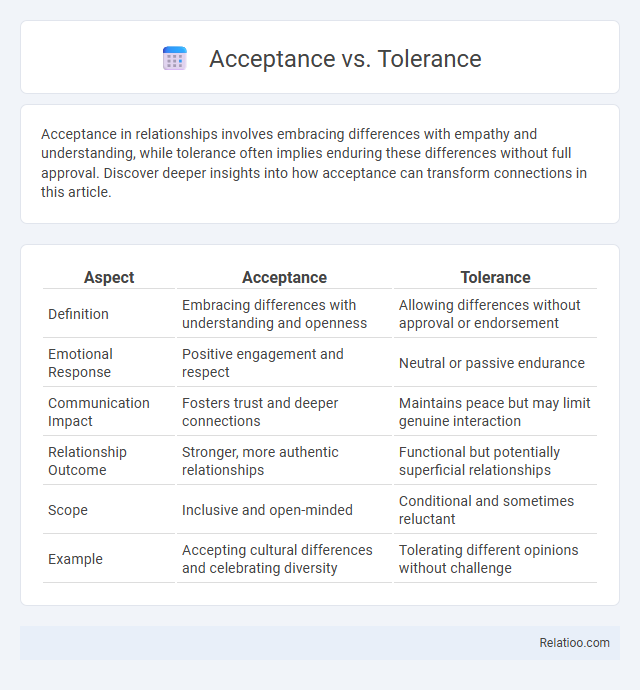Acceptance in relationships involves embracing differences with empathy and understanding, while tolerance often implies enduring these differences without full approval. Discover deeper insights into how acceptance can transform connections in this article.
Table of Comparison
| Aspect | Acceptance | Tolerance |
|---|---|---|
| Definition | Embracing differences with understanding and openness | Allowing differences without approval or endorsement |
| Emotional Response | Positive engagement and respect | Neutral or passive endurance |
| Communication Impact | Fosters trust and deeper connections | Maintains peace but may limit genuine interaction |
| Relationship Outcome | Stronger, more authentic relationships | Functional but potentially superficial relationships |
| Scope | Inclusive and open-minded | Conditional and sometimes reluctant |
| Example | Accepting cultural differences and celebrating diversity | Tolerating different opinions without challenge |
Understanding Acceptance and Tolerance
Acceptance involves fully embracing differences or situations without judgment, fostering genuine respect and inclusion. Tolerance refers to enduring or permitting differences despite personal disagreement or discomfort, often implying a passive stance. Understanding the distinction is crucial; acceptance promotes harmony and positive relationships, whereas tolerance may only prevent conflict without deep connection.
Defining the Key Differences
Acceptance involves fully embracing and valuing differences without judgment, whereas tolerance means allowing differences to exist despite personal discomfort or disagreement. Understanding your stance is crucial, as acceptance promotes genuine inclusion and positive relationships, while tolerance may imply a passive allowance or begrudging endurance. Recognizing these distinctions helps you cultivate deeper empathy and meaningful connections in diverse environments.
Historical Perspectives on Both Concepts
Historical perspectives on acceptance and tolerance reveal their distinct societal roles and evolution; tolerance emerged prominently during the Enlightenment as a pragmatic approach to religious and cultural coexistence, emphasizing peaceful coexistence despite differences. Acceptance, rooted in humanistic and psychological frameworks, advocates embracing diversity and genuine inclusion beyond mere endurance. Your understanding of these concepts deepens by recognizing tolerance as a foundation for civil peace, while acceptance fosters deeper social harmony and personal growth.
The Psychology Behind Acceptance and Tolerance
Understanding the psychology behind acceptance and tolerance reveals that acceptance involves fully embracing differences without judgment, fostering emotional well-being and authentic relationships, while tolerance implies enduring differences with restraint or reluctance, often leading to emotional distance. Acceptance is linked with empathy and psychological flexibility, promoting mental health and resilience, whereas tolerance may mask underlying biases or discomfort. Your ability to nurture acceptance over mere tolerance can significantly enhance interpersonal connections and personal growth.
The Role of Empathy in Acceptance
Empathy plays a crucial role in acceptance by enabling individuals to genuinely understand and share the feelings of others, fostering deeper connections that go beyond mere tolerance or superficial acceptance. While tolerance implies enduring differences without full agreement, acceptance rooted in empathy encourages embracing and valuing those differences in a meaningful way. Your ability to practice empathy transforms interactions, promoting genuine inclusion and respect in diverse social environments.
Social Impacts of Tolerance vs Acceptance
Tolerance often implies enduring differences without necessarily embracing them, which can maintain social divisions and perpetuate exclusion. Acceptance fosters inclusion and mutual respect, promoting stronger social cohesion and reducing prejudice. Societies practicing acceptance tend to experience greater social harmony, improved mental health outcomes, and enhanced collaborative environments compared to those relying solely on tolerance.
Acceptance and Tolerance in Cultural Contexts
Acceptance in cultural contexts involves recognizing and embracing diverse cultural identities and practices as valid and equal, fostering genuine inclusivity and mutual respect. Tolerance, however, implies a passive allowance of cultural differences without necessarily valuing or understanding them, often maintaining underlying biases or hierarchical views. True intercultural harmony is achieved through acceptance, which promotes active engagement and appreciation rather than mere tolerance of cultural diversity.
Overcoming Barriers to Acceptance
Overcoming barriers to acceptance requires understanding the distinct roles of acceptance versus tolerance, where acceptance involves embracing differences fully, while tolerance merely allows for their existence without judgment. Your mindset shifts when you move beyond tolerance, fostering genuine empathy and reducing prejudice, which are critical for building inclusive environments. Strategies to overcome these barriers include self-reflection, education on diverse perspectives, and active engagement in dialogues that challenge preconceived notions.
Fostering Acceptance Beyond Tolerance
Fostering acceptance beyond tolerance requires embracing diversity by genuinely valuing differences rather than merely enduring them. You create inclusive environments when acceptance involves empathy, understanding, and active support for others' unique identities and experiences. This shift from tolerance to acceptance promotes deeper connections, reduces prejudice, and strengthens community cohesion.
Building Inclusive Communities
Building inclusive communities requires moving beyond mere tolerance to genuine acceptance, embracing diversity as a strength rather than a challenge. Acceptance fosters deeper understanding, respect, and belonging, creating environments where Your differences are valued and integrated. This proactive approach cultivates social cohesion, equity, and shared growth within diverse populations.

Infographic: Acceptance vs Tolerance
 relatioo.com
relatioo.com